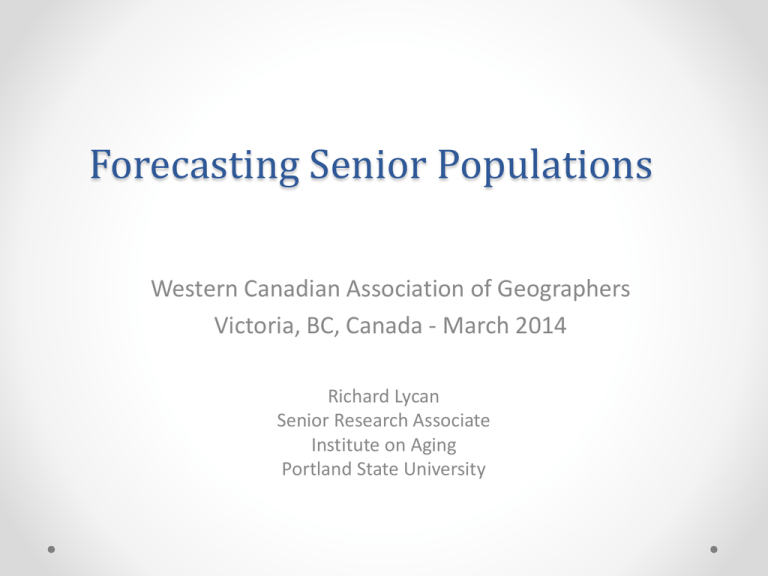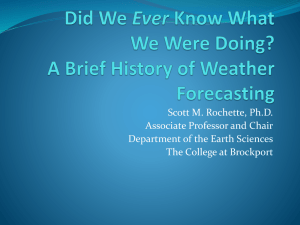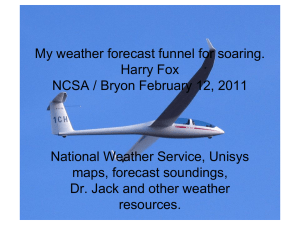
Forecasting Senior Populations
Western Canadian Association of Geographers
Victoria, BC, Canada - March 2014
Richard Lycan
Senior Research Associate
Institute on Aging
Portland State University
The focus of my efforts
• Improve population forecasts for senior populations
o Increase awareness of issues related to forecasting senior populations
o Provide support to forecasters
• Two threads come together
o 1. PSU Population Research Center (PRC) school demography contract business
• Forecasts for small geographies
• Tied to housing and local planning
• Can some of the methods used for school enrollment forecasting be applied to
seniors?
o 2. Oregon land use law requires county coordinated population forecasts
• Law stems from 1973 Senate Bill 100.
• Broad early public support.
• Mandates county planning and zoning. Strong state oversight.
• Now broken?
• Counties now required to use PSU for coordinated forecasts.
• How will the burgeoning senior population be handled in forecasts?
1. Background
Where do the seniors live?
Map Symbols
o
o
o
o
o
o
Size Age55 +
Color % Age 55+
Green < 24%
Yellow 25-49
Red 50-74
Purple 75+
• Portland
examples
• Expand to statewide
•
Numbers and %
o
o
Largest in 25-49%
Number will grow
in 50%+ class
areas
2000
2010
Percent of Age 55+
75+ Population in Block Class, 2000 and 2010
70
60
Percent of Age 55+ in Class
•
50
54.8
49.2
45.7
43.7
40
36.9
30
26.9
35.0
33.0
20
10
10.5 12.3
6.4 8.2
15.0
10.9
5.8 5.7
50-74
75-100
0
0-24
25-49
Percent in Block Age 55+
Types of housing for seniors
Independence
Dependence
Convenience
Services
Housing
Assisted Living /
Personal Care
Health
Care
Age-restricted
(minimal)
Congregate
Continuing care
Assisted
(semi-independent)
living
(moderate)
Nursinge
(dependent)
(minimal)
(as part of nursing care
Characteristic of type
Incidental feature
Chart after Gordon, pp. 32
Where seniors reside by broad housing class
For the map’s age group classes – green, yellow, red, purple
•
In what type of
housing do the age
55+ reside?
•
60% in SFR and 34%
in MFR
•
77% in SFR
•
50% in SFR,18% in
CND, 14% in APT, 10%
RET
•
32% in RET, 16% in
MFG, and 13% in APT
2. Senior Shedding
o Outgrowth of work for Portland Public Schools
o School demography methods
o Senior departures contributed to gentrification
School enrollment – Senior Shedding
Beginning in about 1990
enrollment in Portland’s
central east side elementary
schools began to decline
•
But after 2000 enrollment in
many of those schools began
to increase
•
We found that jump in
enrollments was due mainly
to in-migration of thirty
something families and their
decision to stay put as their
families grew.
•
The vacancies that allowed
the thirty somethings to
move in were created mainly
by the deaths and outmigration of seniors.
2000-2010 | East OMA | GQA | Pop. change = 2,180
Age of Person
•
85 +
80-84
75-79
70-74
65-69
60-64
55-59
50-54
45-49
40-44
35-39
30-34
25-29
20-24
15-19
10-14
05-09
00-04
Net Migration
Deceased
Births
-4,000
-3,000
-2,000
-1,000
0
1,000
2,000
3,000
Number of Persons
•
This created an interest in better understanding the
housing decisions of seniors.
•
The role of departing seniors in the gentrification
process was as important as the gentrifiers.
4,000
3. The county coordinated forecast
•
•
•
•
The Office of Economic Analysis Safe Harbor
Dividing up the county among the cities
Portland Metro
Portland State takes on this task
• The County Coordinated Forecast.
o The Oregon Administrative Rule 660-024-0030(2) states: forecast[s] must take into
account documented long-term demographic trends as well as recent events that have a
Year
reasonable likelihood
of changing historical trends. The population forecast is an
2030
2025
2020
2015
2010
Age
estimate
which,
although
based
on
the
best
available information and methodology,
124,767
120,314
113,115
105,796
106,389
00-04
not be held
unreasonably
level of precision
123,672
116,292 high
108,724
108,004to an
105,735
05-09should
117,185
109,595
109,280
105,905
104,404
10-14
o
Until
recently
Oregon
counties
could
develop
their own population forecast or use the
104,660
105,587
103,229
101,658
103,398
15-19
of Economic
Population
115,591 Forecast , except for the three Portland
113,542
111,641(OEA)
111,357Analysis
20-24Office106,595
143,121
141,090 Metro
140,334Portland
127,762 where
25-29metro127,791
area counties
would develop the forecasts.
Three Counties
157,085
156,277
141,428
135,833
126,806
30-34
161,640
146,350
140,163
128,911
125,189
35-39
149,404
143,093
131,390
126,336
119,203
40-44
144,224
132,481
127,167
118,742
117,747
45-49
o Most recent (2013) by age and sex for 2010
to 2050
132,042
126,663
118,038
115,742
117,344
50-54
o
model115,543 124,203
112,908
113,143
111,089 –component
55-59Uses cohort
108,345
108,157
104,625
90,624
60-64
• Births
- Used
Census
Bureau
trends111,223
for future, computed for counties or groups
103,142
102,757
99,120
84,761
60,035
65-69
counties
95,709
92,020
78,408
54,931
39,370
70-74
69,305
34,360
29,398
75-79
• Deaths
– Life
tables48,315
constructed
for 81,692
counties of groups or counties
58,144
40,229
28,351
23,850
24,769
80-84
Migration
on forecast
migration for state with adjustment for
37,202 of 48,664
32,375
30,808- Base
28,749
85-PP • Net
2,096,168
1,976,686
1,852,144
1,732,524
1,644,635
Total
counties
• The OEA population forecast
OEA Forecast
• The forecast for the Portland three county area
of
• Dividing up the counties
o The county coordinates forecasts for land within the UGB of incorporated cities and the
for the remaining unincorporated areas of the county.
o Staff for smaller counties not well equipped for effort, use of consultants
o No small town wants a forecast indicating slow growth or loss of population
• How the forecasts were carried out
o The forecast for the county
• Use OEA safe harbor forecast – planners tend to use, adjust
• Develop new age/sex forecast – demographers tend to use cohort component
method
• Employment driven vs housing driven forecasts
o The forecast for the incorporated areas
• Discussion of employment, housing, demographics
• Collection of data from local government and businesses
• Allocation of growth – constant shares, changing
• Buildable lands – plans > land for housing> housing > population
• High, medium, low and caveats
Metro’s population Forecasts
• For the Portland area – Clackamas, Multnomah, and
Washington Counties Metro is tasked to produce the county
coordinated forecasts.
• The Metro model begins with forecasts of national economic
forecasts by county and then determines Portland shares of
each industry
• Industry is allocated to location, housing needs for employees,
land for housing, population in housing, and age
characteristics of residents.
• Reservations about how well a largely employment driven
model will forecast retired/senior populations
• Cooperative effort between Metro and PSU Institute on Aging
on housing for seniors.
4. Housing and net migration
o Births, deaths, and net migration key to cohort forecasts
o Net migration the most difficult to forecast
o Forecasters perhaps less familiar with senior housing and
where the seniors might be located in 10, 20 years
o A tool to provide guidance for the forecaster
A linked housing and population database
• Age data for 2000 and 2010 census blocks were summarized to a
common geography – where that was possible.
• Land use data from the Metro tax-lot file and the multiple family
housing inventory were merged and summarized by census block.
• Population by age and sex were summarized for census blocks and
net migration by age calculated.
• An Excel spreadsheet was developed to facilitate the examination of
housing and age characteristics for selected census blocks.
• Examples to follow
• Data available statewide, test case for Portland
Example of senior rental housing
•
Kirkland Union
Manor. Built in
1974 and
expended in
1985 and
1995. It
provides
studio and
one bedroom
apartments.
Senior rental
apartments
that has
existed long
enough to
have steady
state age
distribution.
Deaths
2000
Net Migration
-40
-20
20
0
20
10
40
120
100
80
60
40
20
0
PLX
THM
Kirkland Union Manor
Portland
2010
Population = 400, 99% Age 55+
CND
APT
MFG
RET
85-PP
80-84
75-79
70-74
65-69
60-64
55-59
50-54
45-49
40-44
35-39
30-34
25-29
20-24
15-19
10-14
05-09
00-04
0
Female
RET - Kirkland Union Manor - 286 - 1995 (n-n)
SFR
Population = 356, 96% Age 55+
85-PP
80-84
75-79
70-74
65-69
60-64
55-59
50-54
45-49
40-44
35-39
30-34
25-29
20-24
15-19
10-14
05-09
00-04
85 ++
80-84
75-79
70-74
65-69
60-64
55-59
50-54
45-49
40-44
35-39
30-34
25-29
20-24
15-19
10-14
No of Units
•
Male
10
20
10
0
Female
Male
10
Example of assisted living housing
•
Regency Park
Living Center.
Provides a
range of
services
including
memory care.
The
population of
this
development
is older and
predominately
female. Most
in-movers are
over age 75.
2000
Net Migration
-80
-60
-40
-20
40
0
20
30
40
70
60
50
40
30
20
10
0
PLX
THM
CND
Regency Park Living Center
Beaverton
APT
20
Female
RET - Regency Park Living Center - 20 - NA (n-n)
SFR
Population = 189, 85% Age 55+
2010
Population = 263, 90% Age 55+
85-PP
80-84
75-79
70-74
65-69
60-64
55-59
50-54
45-49
40-44
35-39
30-34
25-29
20-24
15-19
10-14
05-09
00-04
85 ++
80-84
75-79
70-74
65-69
60-64
55-59
50-54
45-49
40-44
35-39
30-34
25-29
20-24
15-19
10-14
No of Units
•
Deaths
MFG
RET
10
85-PP
80-84
75-79
70-74
65-69
60-64
55-59
50-54
45-49
40-44
35-39
30-34
25-29
20-24
15-19
10-14
05-09
00-04
0
Male
10
40
30
20
Female
10
0
Male
10
Example of mixed use block with senior in-migration
•
Holly Tree
Village – A
block in
Beaverton
with a mix of
apartment,
condominium,
and single
family housing
A mix of older
and younger
in-migrants.
Deaths
2000
Net Migration
-20
-15
-10
-5
10
0
5
5
10
60
50
40
30
20
10
0
PLX
THM
2010
Population = 424, 55% Age 55+
CND
APT
Holly Tree Village, Beaverton
MFG
RET
85-PP
80-84
75-79
70-74
65-69
60-64
55-59
50-54
45-49
40-44
35-39
30-34
25-29
20-24
15-19
10-14
05-09
00-04
0
Female
APT - Holly Tree Village - 140 - 1980 (n-n)
SFR
Population = 354, 53% Age 55+
85-PP
80-84
75-79
70-74
65-69
60-64
55-59
50-54
45-49
40-44
35-39
30-34
25-29
20-24
15-19
10-14
05-09
00-04
85 ++
80-84
75-79
70-74
65-69
60-64
55-59
50-54
45-49
40-44
35-39
30-34
25-29
20-24
15-19
10-14
No of Units
•
5
Male
10
10
5
0
Female
5
Male
10
The analysis generalized
• The 2000 and 2010 census blocks are attributed
with:
o
o
o
o
Age 55 plus class (green, yellow, red, and purple on map)
Generalized zoning
Population density
County
• The census block data are cross tabulated by the
above classes and population pyramids and net
migration estimates are computed.
• A reason for choosing these data is that they are
available for all counties in Oregon.
• The original
map showing
where the
seniors live.
• Converted to
block polygon
representation.
• Age 55 plus
class added to
block point files
for 2000 and
2010.
• Density
measure added
to block point
files.
• Zoning added to
block point files
Multi-family housing in Multnomah Co.
•
•
•
•
The green areas on the
map house many of the
county’s younger
families and many of
Portland’s post WWII
garden type apartments.
Apartments in the
yellow areas house more
families in their thirties
and forties than in their
twenties, but these
older age groups are out
migrating. The age 55
and over population
includes the baby
boomers.
2000
-10
-20
In the purple areas on
the map the net inmovers are mainly age
65 and older. Mortality
has thinned out older
cohorts of males.
-15
-5
-10
-5
-5
0
5
5
10
5
-10
-20
-15
-5
-10
-5
% Male
85 ++
80-84
75-79
70-74
65-69
60-64
55-59
50-54
45-49
40-44
35-39
30-34
25-29
20-24
15-19
10-14
05-09
00-04
-5
0
% Female
0
5
% Male
Net
Net
Mig
Mig
(Age
(Age
10+):
10+):
9,659
2,191
1,693
685
85 ++ 85 ++
80-84 80-84
75-79 75-79
70-74 70-74
65-69 65-69
60-64 60-64
55-59 55-59
50-54 50-54
45-49 45-49
40-44 40-44
35-39 35-39
30-34 30-34
25-29 25-29
20-24 20-24
15-19 15-19
10-14 10-14
-4-2-30
-15
85 ++
80-84
75-79
70-74
65-69
60-64
55-59
50-54
45-49
40-44
35-39
30-34
25-29
20-24
15-19
10-14
05-09
00-04
0
Net Migration
-20
-40
-4
-6
Population: 4,022
87,006
46,951
5,090
85 ++
80-84
75-79
70-74
65-69
60-64
55-59
50-54
45-49
40-44
35-39
30-34
25-29
20-24
15-19
10-14
05-09
00-04
% Female
In the red areas most inmovers are age 50 and
older with a significant
in-movement of persons
age 75 and older.
2010
Population:
Population:42,936
67,475
5,181
3,541
85 ++
80-84
75-79
70-74
65-69
60-64
55-59
50-54
45-49
40-44
35-39
30-34
25-29
20-24
15-19
10-14
05-09
00-04
-2 0 -20
-10 0
85 ++
80-84
75-79
70-74
65-69
60-64
55-59
50-54
45-49
40-44
35-39
30-34
25-29
20-24
15-19
10-14
2
% Deaths
-10
-5
2
4
4 0 6 6
% Net Migration
Zoning Class:
Multifamily Residential
Density Class:
GT 0.0 persons per acre
Age 55 Class:
County:
0%-24%
25%-49%
50%-74%
75%-100%
Multnomah
All graphed data as percent
of total population
10
5 88
10
20
5
10
5
Single-family housing in Multnomah Co.
•
•
•
•
In single family housing in
the green area
households moving in are
mainly in their late
twenties of their thirties.
The single family housing
in this area is mainly post
WWII.
In the yellow areas on the
map the families are
about 10 years older and
families age 20-24 and
over age 55 are moving
out.
In the red areas on the
map there is a mix of inmigration of families in
their thirties and families
over age 55.
2000
-10
-20
-5
-15-3 -5
-10 -1
-5
0
1
0
5 3 5
10
5
-10
-20
-5
-15-3 -5
-10 -1
85 ++
80-84
75-79
70-74
65-69
60-64
55-59
50-54
45-49
40-44
35-39
30-34
25-29
20-24
15-19
10-14
05-09
00-04
-5
0
% Female
1
0
5 3 5
% Male
Net
Net
Mig
Mig
(Age
(Age
10+):
10+):
1,584
3,383
2,249
436
85 ++
80-84
75-79
70-74
65-69
60-64
55-59
50-54
45-49
40-44
35-39
30-34
25-29
20-24
15-19
10-14
-8 -20
-2
-4
85 ++
80-84
75-79
70-74
65-69
60-64
55-59
50-54
45-49
40-44
35-39
30-34
25-29
20-24
15-19
10-14
05-09
00-04
% Male
Net Migration
In the purple areas on the
map most of the families
in single family housing
are age 55 and older,
some in age restricted
housing.
Population: 1,989
196,735
228,039
14,677
85 ++
80-84
75-79
70-74
65-69
60-64
55-59
50-54
45-49
40-44
35-39
30-34
25-29
20-24
15-19
10-14
05-09
00-04
% Female
-10
-30
-4
-6
2010
Population:
Population:
Population:
181,820
214,768
13,461
2,097
85 ++
80-84
75-79
70-74
65-69
60-64
55-59
50-54
45-49
40-44
35-39
30-34
25-29
20-24
15-19
10-14
05-09
00-04
-6
85 ++
80-84
75-79
70-74
65-69
60-64
55-59
50-54
45-49
40-44
35-39
30-34
25-29
20-24
15-19
10-14
-10
-2
0 -4
% Deaths
85 ++
80-84
75-79
70-74
65-69
60-64
55-59
50-54
45-49
40-44
35-39
30-34
25-29
20-24
15-19
10-14
-2 0
2
Zoning Class:
Single Family Residential
Density Class:
GT 0.0 persons per acre
Age 55 Class:
County:
0%-24%
25%-49%
50%-74%
75%-100%
Multnomah
All graphed data as percent
of total population
0
% Net Migration
10
4 2
2
20
6
4
10
5
Mortality rates affected by Education, Affluence
•
•
•
•
Caveat – Analyses in
paper used national
mortality rates by
age and sex.
Recent research
shows that mortality
rates are
considerably lower
for persons with
more education,
higher SES.
Block level mortality
data for Portland
show spatial
variations in average
of death, shown
here for females.
Females live longer
in some areas of
senior housing, but
not those that
accommodate those
in failing health.
5. Conclusions and next steps
• We can link the forecasting of seniors to community plans and housing as
we do for school demography studies.
• The smallest geography for which we have counts of seniors by age is the
block and blocks can be quite heterogeneous. For students we can link
students directly to housing type by home address.
• National mortality rates used in the various models need to be adjusted
for local variations due to education and SES.
• The tools linking zoning and the housing setting of seniors may provide
some useful guidance for population forecasters, but they do not directly
provide a forecast.
• The tools as presently implemented have bugs that need to be addressed.
The density measure is a problem.
• Extending the use of the tool to Oregon’s more rural counties may lead to
some useful insights – or to problems in interpreting the results of the
tool.
• Land-use planning in Oregon
o
o
•
Senior housing
o
o
o
•
Adler, Sy. Oregon Plans, the Making of an Unquiet Land-Use Revolution, Oregon State University
Press, 2012.
Walker, Peter A. and Patrick T. Hurley, Planning Paradise, Politics and Visioning of Land Use in Oregon,
The University of Arizona Press, 2011.
Brecht, Susan. Analyzing Senior’s Housing Markets, the Urban Land Institute, 2002.
Gordon, Paul A. Senior’s Housing and Care Facilities: Development, Business, and Operations, the
Urban Land Institute, 1998.
Reginer, Victor and Jon Pynoos. Housing the Aged: Design Directives and Policy Considerations,
Elsevier Publishing Co., 1987.
Web links
o
o
o
o
o
o
o
Oregon Office of Economic Analysis Population Forecasts http://www.oregon.gov/DAS/oea/Pages/demographic.aspx
Lane County , example of county coordinated population forecast http://www.lanecounty.org/departments/pw/lmd/landuse/pages/population_forecasts.aspx
Metro, Metroscope methodology - http://www.oregonmetro.gov/index.cfm/go/by.web/id=24906
Metro, Senior Forecast - http://library.oregonmetro.gov/files/no_5._agedistribution.pdf
Metro/IOA Age friendly city - http://news.oregonmetro.gov/1/post.cfm/portland-and-the-regionplan-for-an-aging-population
Senior shedding and school enrollment - http://www.pdx.edu/prc/news-and-presentations-fromthe-population-research-center
This paper - http://www.pdx.edu/ioa/news-and-presentations-from-the-institute-on-aging
Richard Lycan
Senior Research Associate
Institute on Aging
Portland State University
lycand@pdx.edu
503-880-3230










